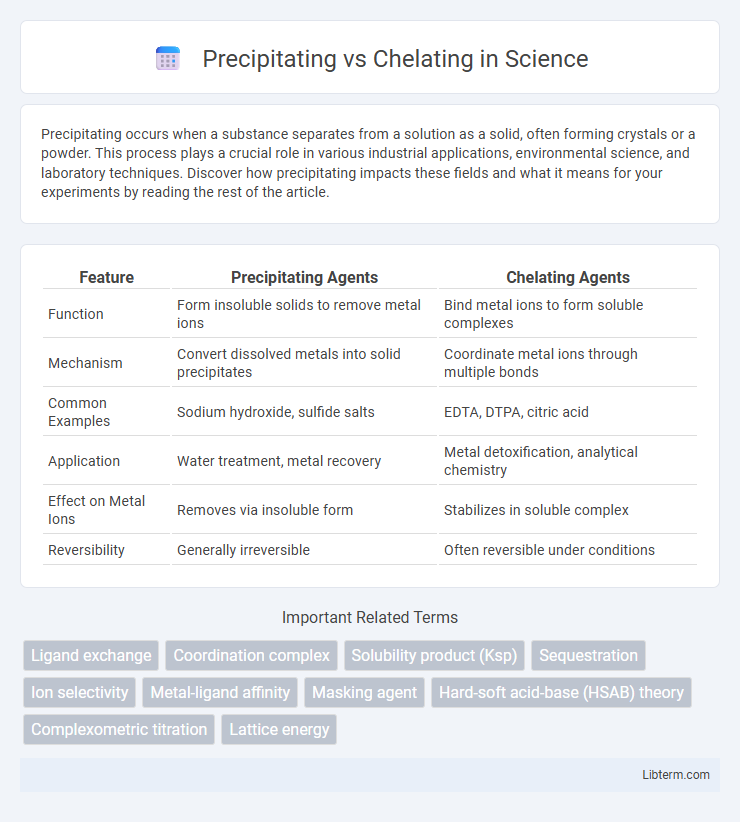Precipitating occurs when a substance separates from a solution as a solid, often forming crystals or a powder. This process plays a crucial role in various industrial applications, environmental science, and laboratory techniques. Discover how precipitating impacts these fields and what it means for your experiments by reading the rest of the article.
Table of Comparison
| Feature | Precipitating Agents | Chelating Agents |
|---|---|---|
| Function | Form insoluble solids to remove metal ions | Bind metal ions to form soluble complexes |
| Mechanism | Convert dissolved metals into solid precipitates | Coordinate metal ions through multiple bonds |
| Common Examples | Sodium hydroxide, sulfide salts | EDTA, DTPA, citric acid |
| Application | Water treatment, metal recovery | Metal detoxification, analytical chemistry |
| Effect on Metal Ions | Removes via insoluble form | Stabilizes in soluble complex |
| Reversibility | Generally irreversible | Often reversible under conditions |
Understanding Precipitating and Chelating Agents
Precipitating agents are substances that form insoluble compounds by reacting with metal ions, causing them to separate from solution as solid precipitates, commonly used in water treatment and chemical analysis. Chelating agents, such as EDTA, bind metal ions through multiple coordination sites, forming stable, soluble complexes that prevent metal ion precipitation and are widely utilized in medicine and environmental remediation. Understanding the differences in mechanisms and applications of precipitating versus chelating agents is crucial for effectively managing metal ion interactions in various industrial and laboratory processes.
Key Differences Between Precipitation and Chelation
Precipitation involves forming an insoluble solid from a solution when two ions combine, while chelation refers to the binding of metal ions by organic molecules called chelating agents. Precipitation is typically a physical separation process based on solubility principles, whereas chelation stabilizes metal ions through complex formation, enhancing solubility and bioavailability. Key differences include the reversibility of chelation complexes versus the irreversible nature of precipitates and the selectivity of chelating agents for specific metal ions compared to the broader ion interaction in precipitation.
Chemical Principles Behind Precipitation
Precipitation involves the formation of a solid from a solution when the product of ion concentrations exceeds the solubility product constant (Ksp), leading to supersaturation and nucleation of the precipitate. Chelating agents, in contrast, bind metal ions through multiple coordination sites, stabilizing them in solution and preventing precipitation by reducing free ion concentrations below the Ksp threshold. Understanding the chemical equilibrium and solubility product principles is crucial for controlling precipitation reactions in analytical chemistry and environmental remediation.
The Science of Chelation Explained
Chelation involves the formation of stable complexes between chelating agents and metal ions, effectively sequestering metals to prevent their participation in unwanted chemical reactions. Unlike precipitation, which forms insoluble compounds that settle out of solution, chelation ensures metals remain soluble and bioavailable while reducing toxicity and facilitating targeted metal removal. This controlled binding mechanism underpins applications in medicine, environmental remediation, and analytical chemistry by enhancing metal ion stability and selectivity.
Applications of Precipitating Agents
Precipitating agents are widely applied in water treatment processes to remove heavy metals and reduce hardness by forming insoluble compounds that settle out of solution. These agents, such as calcium hydroxide and sodium carbonate, are essential in industrial wastewater management to recover valuable metals and prevent environmental contamination. The efficiency of precipitation methods makes them preferred for large-scale operations requiring cost-effective and straightforward removal of dissolved substances.
Common Uses of Chelating Agents
Chelating agents are widely used in medicine to treat heavy metal poisoning by binding toxic metals such as lead, mercury, and arsenic, facilitating their excretion from the body. In industrial applications, chelating agents like EDTA prevent metal ion contamination in processes such as textile, paper manufacturing, and water treatment. Agricultural practices utilize chelating agents to enhance micronutrient availability in soil, promoting better plant growth and nutrient uptake.
Advantages and Limitations of Precipitating Methods
Precipitating methods are advantageous in removing heavy metals from wastewater due to their simplicity, cost-effectiveness, and ability to handle large volumes. Limitations include the production of sludge that requires proper disposal, potential incomplete removal of metals at low concentrations, and sensitivity to pH changes affecting precipitation efficiency. Despite these challenges, precipitating remains a widely used technique for initial heavy metal removal before further refining processes.
Benefits and Drawbacks of Chelation Techniques
Chelation techniques effectively remove heavy metals from water by forming stable, soluble complexes, enhancing contaminant extraction and reducing environmental toxicity. These methods offer precise metal targeting and improved selectivity compared to precipitation, but they often incur higher costs due to specialized chelating agents and require careful management to prevent secondary pollution from chelate disposal. Despite these drawbacks, chelation remains advantageous in treating complex wastewater streams where conventional precipitation is inefficient or ineffective.
Precipitating vs Chelating: Which to Choose?
Precipitating agents form insoluble compounds by reacting with specific ions, making them ideal for removing contaminants through solid separation, while chelating agents bind metal ions tightly, enhancing solubility and stability. Choosing between precipitating and chelating methods depends on factors like the type of metal ion, desired outcome, and treatment environment. Precipitation suits heavy metal removal in wastewater, whereas chelation is preferred for metal ion stabilization in complex biological or industrial applications.
Future Trends in Precipitation and Chelation Research
Future trends in precipitation and chelation research emphasize the development of advanced selective chelating agents and eco-friendly precipitating compounds for improved metal recovery and environmental remediation. Innovations in nanotechnology and biotechnology enable more efficient and sustainable methods for contaminant removal and resource recycling. Emerging computational modeling techniques enhance the design of optimized chelators and precipitating materials, accelerating their application in industrial and clinical settings.
Precipitating Infographic

 libterm.com
libterm.com